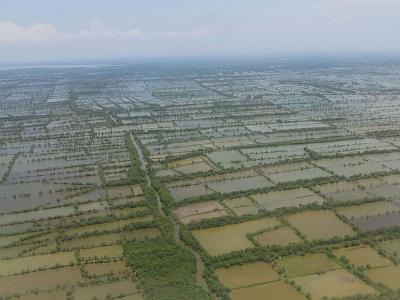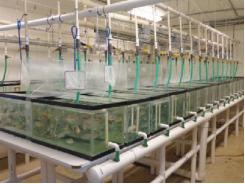Opinion: Aquacultures way forward is to embrace zonal management

Certification recognizes responsible production, but fails to account for external pathogens, pollution
An overview of aquaculture ponds in close proximity to one another. Zonal management requires the industry to explicitly recognize that one seafood farm can have an adverse impact on another. Photo by Jack Morales, courtesy of Sustainable Fisheries Partnership.
Compared to the rich history of fishing, seafood farming is still a new industry that has experienced many growing pains. Aquaculture operators have learned hard lessons, from market fluctuations to catastrophic disease outbreaks. However, the industry has come out of this process as a highly efficient producer of protein and an important source of nutrition; the men and women who made it all happen should take pride in this progress.
Now, it’s time to discuss the next step the aquaculture industry must take in the journey towards sustainable seafood farming. The challenge ahead requires providers to think outside their comfort zones but is vital to achieving truly sustainable aquaculture.
This next step – a concept known as zonal management – requires the industry to explicitly recognize that one seafood farm can have an adverse impact on another if they are in close enough proximity to each other or connected through shared supply chains. One farm’s discharge can contaminate the water needed by another and disease can spread unchecked. This problem can affect any type of farm anywhere in the world, be it pangasius farms along the Mekong River in Vietnam, salmon pens off the coast of Chile or shrimp farms in India.
The idea that farms’ health and safety are interconnected is not a new one – many salmon farmers in particular are aware of the potential damage that can be done, and many companies have been imposing their own standards regarding spacing of pens for years.
That’s a great start, but it’s not enough. We must completely redefine our definition of “sustainable” aquaculture to include zonal management measures.
The risks from disease and pollution can be dramatically reduced by adopting strategies that go beyond the farm level and address the risks across a whole production zone.
Our current efforts around improvement are very much focused at the farm level through certification; but a well-run farm is not protected from the disease or water pollution of another farm close by. The certification of farms to a credible standard – like the Global Aquaculture Alliance’s Best Aquaculture Practices (BAP), GlobalGAP or the Aquaculture Stewardship Council (ASC) – is well worth having, but it needs to be combined with the management of entire aquaculture production zones before the industry can become truly sustainable.
This message is already being recognized by BAP in the development of their zone management standard, in the proposed revision to the ASC standard to include area management, and through the inclusion of area management in the additional criteria of the Global Sustainable Seafood Initiative (GSSI) benchmarking tool.
In addition to these very welcome developments among certifications, Sustainable Fisheries Partnership is playing an active role to promote the zonal management approach and support industry players that want to take practical action. In Hainan, China, SFP worked with industry stakeholders to improve the sustainability of tilapia farming. As a result, that sector is now employing zonal aquaculture with positive results.
We should be able to implement zonal aquaculture and achieve sustainable seafood farming using a similar model. Just as the daily work of fishermen is necessarily guided by shorter-term, more immediate goals, we cannot expect the average seafood farmer to focus on the bigger picture. We can, however, expect vertically integrated producer companies, hatcheries, or processors see the value. These companies and related stakeholders have big investments and a clear incentive to support an overarching zonal approach that leads to a truly “sustainable” industry.

Photo by Jack Morales, courtesy of Sustainable Fisheries Partnership.
Beaver Street Fisheries and Sea Farms are developing an aquaculture improvement project with local processors and the Shrimp Farmers Club in Surat Thani, Thailand, to address farm and zonal management needs to reduce the impact of early mortality syndrome (EMS) and other diseases.
By strengthening, or creating, local industry associations in areas where they source farmed seafood, these companies can help steer producers along a path of improvement based on a locally developed Code of Good Practice that includes a strategy to jointly control disease.
Such an approach can show the market that this is a movement across the whole industry, not just a few farms here and there. Coordinated disease management creates more consistent and secure production. It reduces the costs for individual farms to manage disease, which also benefits small enterprise farmers and provides the market with greater confidence in consistency and quality of supply.
Effective zonal management can have other benefits as well. For instance, zones can define themselves as distinct brands in the marketplace and achieve differentiation from competitors. The insurance industry will also welcome greater efforts to reduce production risks and this may have real benefits to farmers in the future through increased access to credit and insurance.
The aquaculture industry is set to continue its dramatic expansion in the years to come but needs to avoid the catastrophes that have bedeviled it in the past. The risks from disease and pollution can be dramatically reduced by adopting strategies that go beyond the farm level and address the risks across a whole production zone. Today we have a welcome increase in responsibly managed farms; tomorrow we must see the achievement of a sustainable industry.
---
Anton Immink
Anton Immink is the global aquaculture director for Sustainable Fisheries Partnership and an inaugural member of the Global Aquaculture Advocate’s Editorial Advisory Board. Anton has 20 years’ experience in aquaculture management, spanning commercial, social and environmental projects across Asia and Africa.
Related news
Tools

Phối trộn thức ăn chăn nuôi

Pha dung dịch thủy canh

Định mức cho tôm ăn

Phối trộn phân bón NPK

Xác định tỷ lệ tôm sống

Chuyển đổi đơn vị phân bón

Xác định công suất sục khí

Chuyển đổi đơn vị tôm

Tính diện tích nhà kính

Tính thể tích ao



 The ancient practice of paddy-cum-fish culture
The ancient practice of paddy-cum-fish culture  Parasite treatment reduces F. columnare infection in tilapia
Parasite treatment reduces F. columnare infection in tilapia